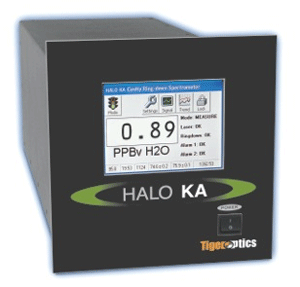- News
20 July 2012
Tiger Optics launches compact trace gas analyzer for 200ppt contaminant detection in UHP gas
 At the Semicon West 2012 trade show in San Francisco, CA, USA (10-12 July), laser-based trace gas analyzer manufacturer Tiger Optics LLC of Warrington, PA, USA unveiled the HALO-KA, which can detect traces of contaminants to 200 part-per-trillion levels in an ultra-high-purity (UHP) gas stream.
At the Semicon West 2012 trade show in San Francisco, CA, USA (10-12 July), laser-based trace gas analyzer manufacturer Tiger Optics LLC of Warrington, PA, USA unveiled the HALO-KA, which can detect traces of contaminants to 200 part-per-trillion levels in an ultra-high-purity (UHP) gas stream.
The HALO-KA has what is claimed to be the smallest footprint of any high-purity analyzer on the market, providing cost savings. With a low detection limit of 500ppt H2O in nitrogen (200ppt in helium), two of the new instruments can fit in a 19-inch rack. Moreover, its patented continuous-wave cavity ring-down spectroscopy (CW CRDS) principle of operation requires no moving parts or calibration, saving on down-time, labor, and consumables, the firm adds.
The HALO-KA is the latest addition to a platform that debuted in 2006 as the HALO, a ‘mini’ device measuring moisture in a range from 2ppb to 20ppm, offering the speed, specificity and reliability of the original Tiger tools but at about half of the price and a quarter of the size. The original HALO was conceived by Dr Farhang Shadman, director of the NSF/SRC Engineering Research Center for Environmentally Benign Semiconductor Manufacturing at the University of Arizona.
The HALO+ analyzer, introduced at Semicon West 2007, provided detection limits down to 400ppt for fields as diverse as gas manufacturing, semiconductor fabrication, and national metrology institutes. When a user requested an analyzer with an extended upper detection limit, Tiger Optics responded in 2010 with the HALO-500-H2O, providing the widest detection range of any Tiger product.
“Our newest HALO is unique in its ability, as an all-in-one device, to monitor extremely low levels of contamination in a UHP gas stream,” claims founder & chief executive Lisa Bergson. “Not only can the HALO-KA monitor moisture, but we also have systems available to monitor a wide variety of analytes in both inert and corrosive gases,” she adds.
